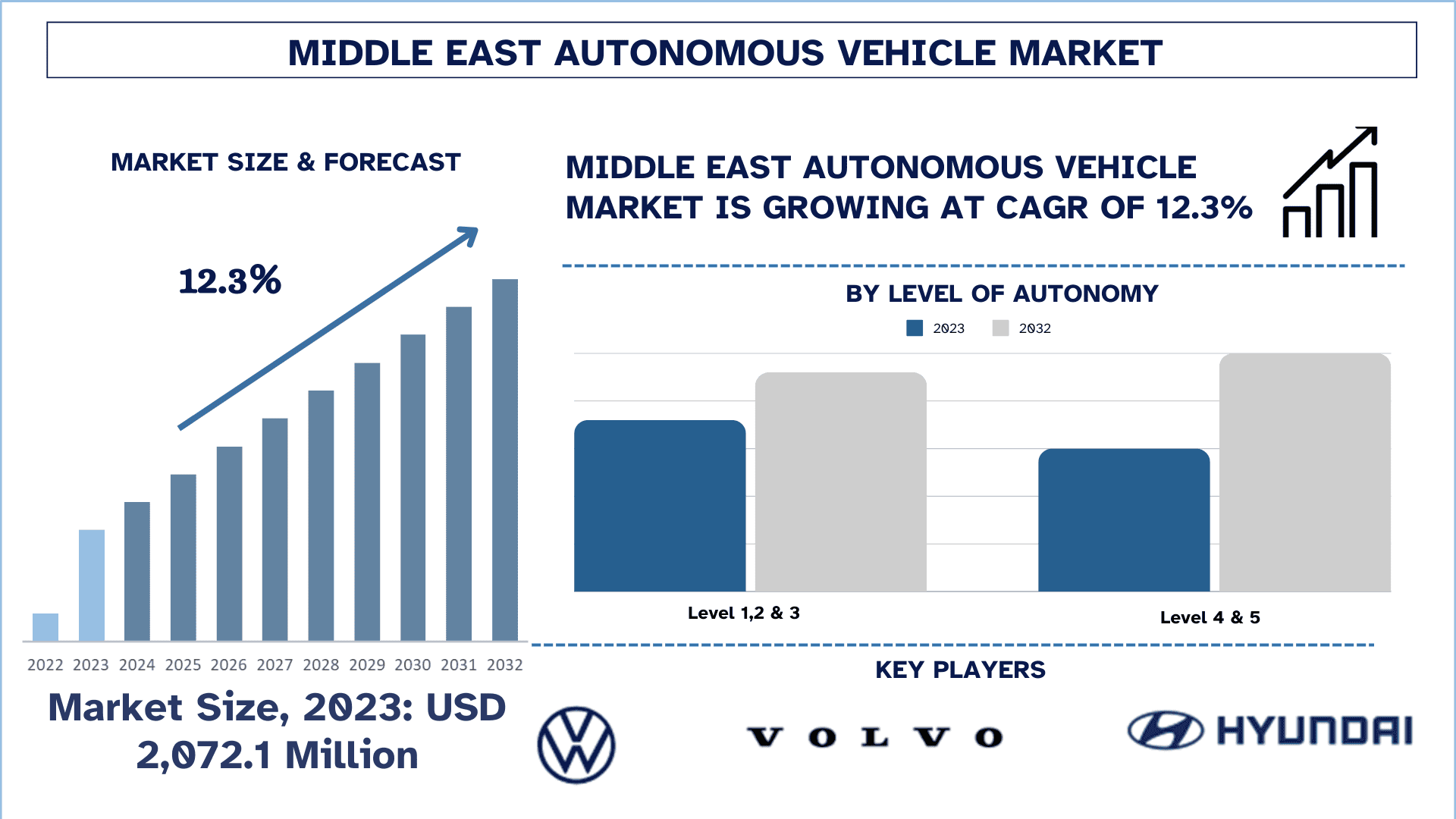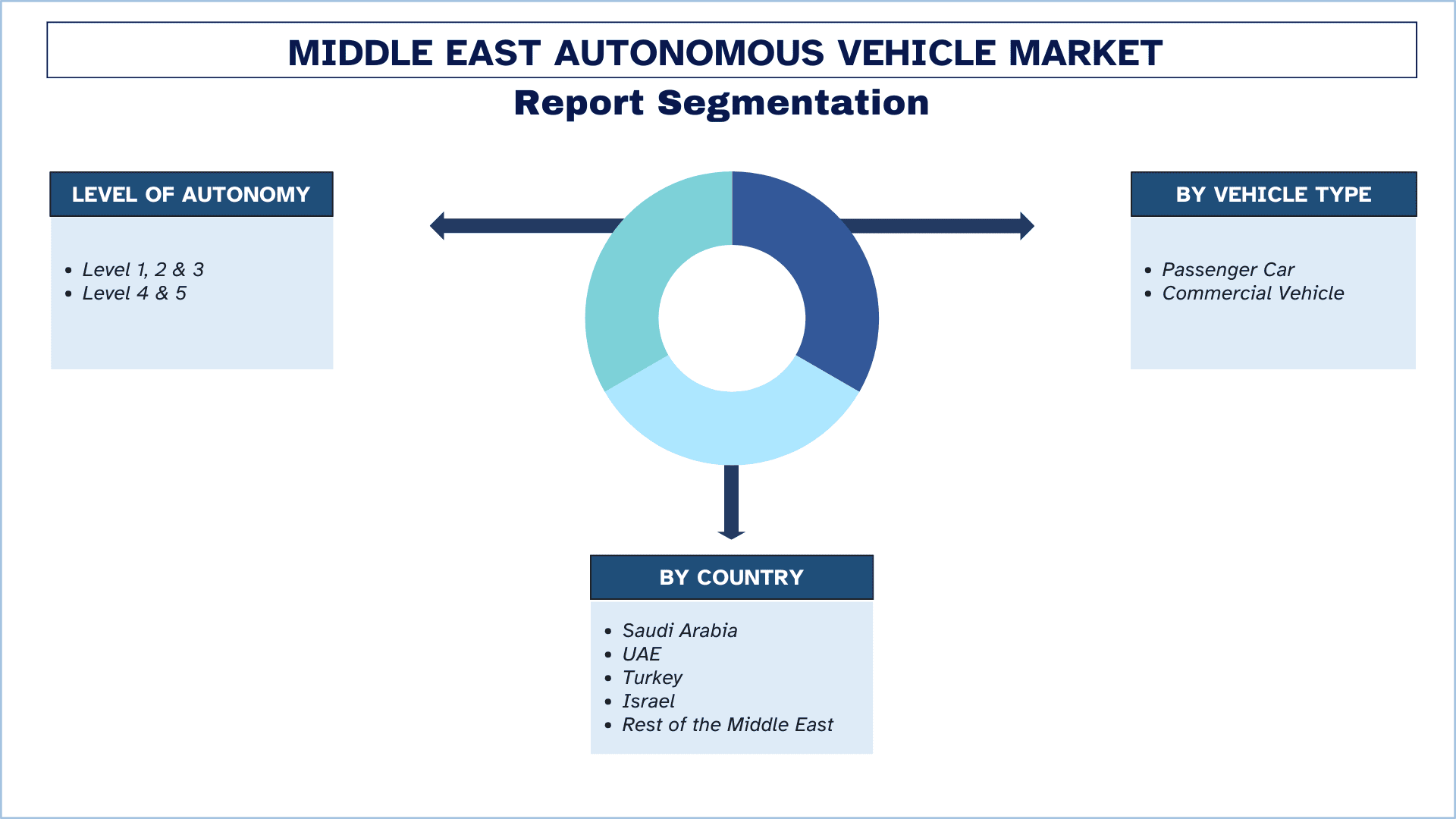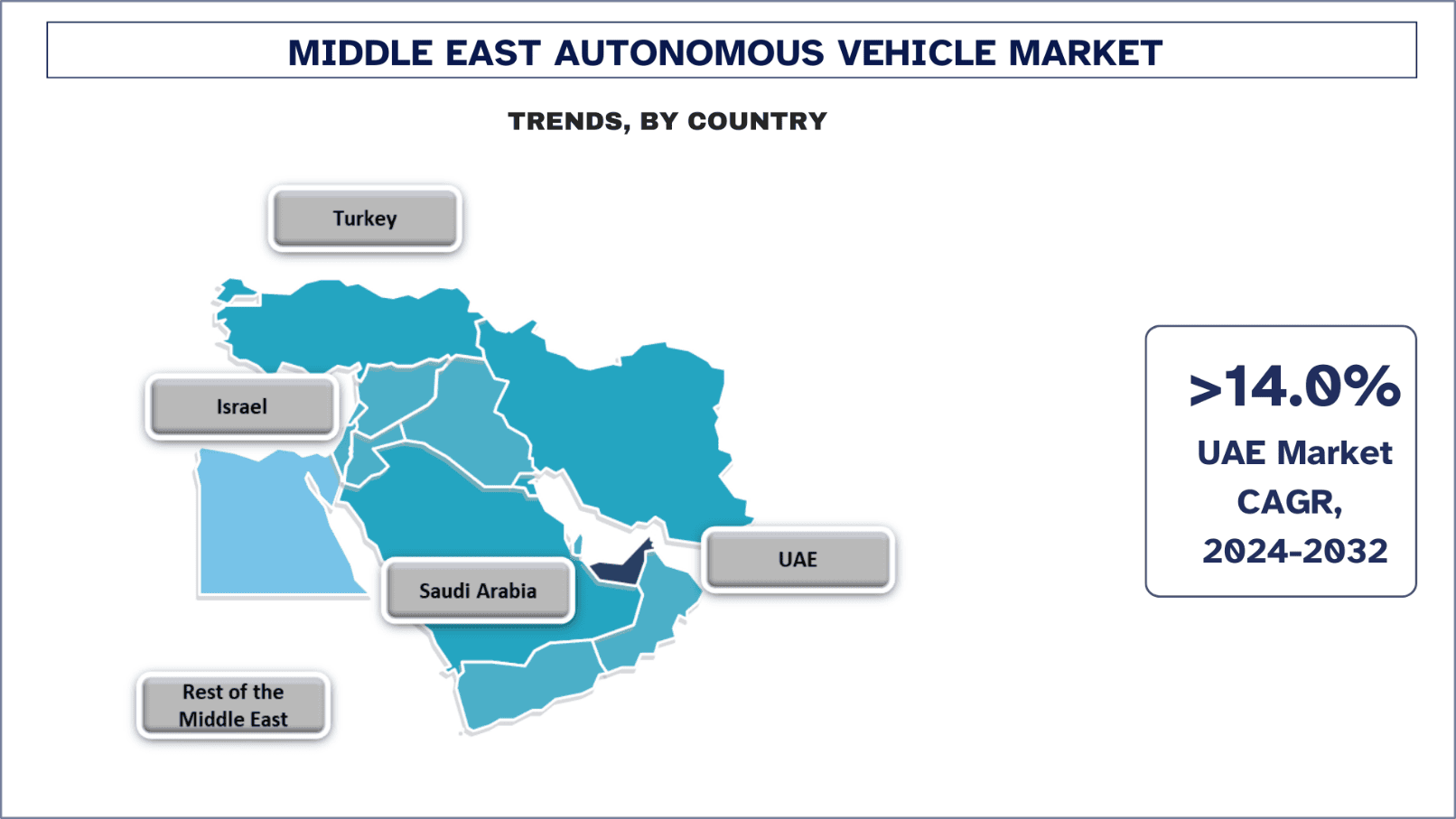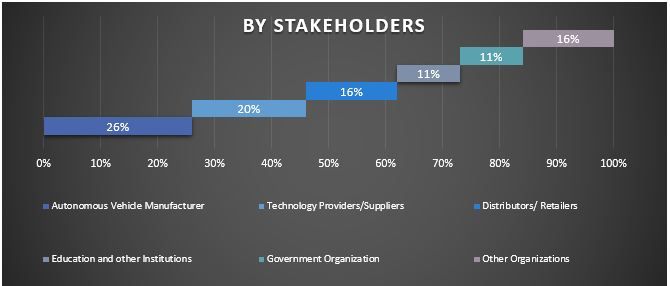- Strona główna
- O nas
- Branża
- Usługi
- Czytanie
- Kontakt
Rynek pojazdów autonomicznych na Bliskim Wschodzie: bieżąca analiza i prognoza (2024-2032)
Nacisk na Poziom Autonomii (Poziom 1, 2 i 3 oraz Poziom 4 i 5); Typ Pojazdu (Samochody Osobowe, Pojazdy Użytkowe); Kraj (Arabia Saudyjska, ZEA, Turcja, Izrael, Reszta Bliskiego Wschodu)

Wielkość i prognoza rynku pojazdów autonomicznych na Bliskim Wschodzie
Wartość rynku pojazdów autonomicznych na Bliskim Wschodzie oszacowano na 2 072,1 mln USD w 2023 r. i oczekuje się, że w okresie prognozy (2024-2032) będzie on rósł w silnym tempie CAGR wynoszącym około 12,3%. Technologia pojazdów autonomicznych to rosnący rynek w regionie Bliskiego Wschodu, ponieważ wiele firm planuje oferować swoje modele z odpowiednimi technologiami. Ponadto oczekuje się, że inwestycje rządowe w regionie wraz ze zwiększonym naciskiem na rozwój technologiczny spowodują ekspansję rynku pojazdów autonomicznych w regionie Bliskiego Wschodu. Na przykład w 2023 r. rząd ZEA zatwierdził pierwszą wstępną krajową licencję na samochody autonomiczne. Wstępna licencja została przyznana chińskiej firmie WeRide. Kraj ten postawił sobie za cel przeniesienie 25% transportu na w pełni autonomiczną obsługę do 2030 roku.
W innym przypadku, w 2023 r. rząd Kataru przedstawił pięcioletni plan regulacji dotyczących pojazdów autonomicznych w ramach inteligentnego i świadomego ekologicznie systemu transportu.
Analiza rynku pojazdów autonomicznych na Bliskim Wschodzie
Rynek pojazdów autonomicznych na Bliskim Wschodzie odnotował znaczny wzrost w minionych latach. Pojazdy autonomiczne to pojazdy komercyjne i osobowe, które mogą jeździć autonomicznie przy pomocy wbudowanego sprzętu i oprogramowania. Sprzęt obejmuje czujniki, procesor, radary itp. w celu zbierania ogromnych ilości danych w celu oceny warunków drogowych i ruchu oraz kierowania pojazdem po pasie ruchu ze stałą prędkością, aby zmniejszyć wysiłek kierowcy. Systemy te zapewniają również pomoc przy hamowaniu, gdy konieczne jest nagłe hamowanie.
Trendy na rynku pojazdów autonomicznych na Bliskim Wschodzie
Jednym z kluczowych trendów obserwowanych na Bliskim Wschodzie jest stopniowy postęp w zakresie cyfryzacji transportu i dalszej integracji sztucznej inteligencji w pojazdach. Ponieważ technologie sztucznej inteligencji stają się coraz bardziej zdolne do radzenia sobie w różnych warunkach drogowych, w nadchodzących latach nastąpi dalszy wzrost wykorzystania technologicznego pojazdów autonomicznych.
Cyfryzacja transportu i integracja sztucznej inteligencji:
Wpływ technologii opartych na sztucznej inteligencji pomaga przezwyciężyć wyzwania, przed którymi stoją pojazdy autonomiczne podczas funkcjonowania w różnorodnych warunkach rzeczywistych. Integracja systemu transportowego ze sztuczną inteligencją na Bliskim Wschodzie poprawia wydajność i bezpieczeństwo pojazdów autonomicznych oraz promuje ogólną strukturę transportu.
Poprawa zarządzania ruchem i transportem: Systemy kontroli ruchu oparte na technologii sztucznej inteligencji są instalowane w celu zmniejszenia problemów z ruchem w zatłoczonych miastach. Korzystanie z systemu wykorzystującego wiele źródeł informacji, w tym obrazy z kamer drogowych, czujników i GPS, a także komputerowe przewidywanie „kroków” na następnym obrazie B, optymalizacja sygnalizacji świetlnej, przewidywanie zatorów i korekty przepływu ruchu są możliwe w czasie rzeczywistym. Ten samochodowy system może być również używany, gdy wdrażana jest technologia AV, co pozwala na lepszą koordynację ruchu między pojazdami AV i pojazdami prowadzonymi przez ludzi.
Komunikacja między pojazdami (IVC) / komunikacja pojazd-wszystko (V2X): Komunikacja wewnątrzpojazdowa (IVC) wspiera ruch/dojazdy pojazdów autonomicznych w warunkach ruchu drogowego wraz z innymi pojazdami, infrastrukturą drogową i pieszymi, a także systemami ruchu. Ponadto zwiększa to operacyjność pojazdów autonomicznych, umożliwiając im komunikację z innymi pojazdami w otoczeniu, takimi jak drogi, sygnalizacja świetlna i przeszkody.

Oczekuje się, że Arabia Saudyjska będzie rosła ze znacznym CAGR w okresie prognozy
Arabia Saudyjska ma spory udział w rynku pojazdów autonomicznych na Bliskim Wschodzie. Niektóre z czynników przypisywanych wzrostowi to większe skupienie się rządu na przyjmowaniu zasad i środków dotyczących pojazdów autonomicznych, dodatkowo skupienie się sektora publicznego i prywatnego na rozwoju infrastruktury i zwiększaniu liczby opcji dostępnych w ramach pojazdów autonomicznych. Ponadto pojawiło się wiele aktualizacji dotyczących wprowadzenia różnych samochodów bez kierowcy w kraju, co będzie miało kluczowe znaczenie dla ekspansji rynku w nadchodzących latach. Na przykład w 2024 r. rząd Arabii Saudyjskiej uruchomił projekt bez kierowcy, w ramach którego pierwszy samochód bez kierowcy dla saudyjskich urzędników zostanie dostarczony do 2025 r. Ponadto kraj ten planuje przestawić co najmniej 15% wszystkich pojazdów na autonomiczne do 2030 r.

Przegląd branży pojazdów autonomicznych na Bliskim Wschodzie
Rynek pojazdów autonomicznych na Bliskim Wschodzie jest konkurencyjny i rozdrobniony, z obecnością kilku krajowych graczy rynkowych. Kluczowi gracze przyjmują różne strategie rozwoju, aby zwiększyć swoją obecność na rynku, takie jak partnerstwa, umowy, współpraca, wprowadzanie nowych produktów na rynek, ekspansja geograficzna oraz fuzje i przejęcia. Niektórzy z głównych graczy działających na rynku to Renault SA, Bayerische Motoren Werke AG, Ford Motor Co., Mercedes-Benz Group AG, Hyundai Motor Co., General Motor Co., Volkswagen AG, Toyota, AB Volvo i Stellantis Group.
Zakres raportu dotyczącego rynku pojazdów autonomicznych na Bliskim Wschodzie
Atrybut raportu | Szczegóły |
Rok bazowy | 2023 |
Okres prognozy | 2024-2032 |
Dynamika wzrostu | Przyspieszenie przy CAGR wynoszącym ~12,3% |
Wielkość rynku w 2023 r. | 2 072,1 mln USD |
Analiza krajowa | Arabia Saudyjska, ZEA, Turcja, Izrael i reszta Bliskiego Wschodu |
Główny region przyczyniający się do wzrostu | Oczekuje się, że ZEA będą rosły w najwyższym tempie CAGR w prognozowanym okresie. |
Profilowane firmy | Renault SA, Bayerische Motoren Werke AG, Ford Motor Co., Mercedes-Benz Group AG, Hyundai Motor Co., General Motor Co., Volkswagen AG, Toyota, AB Volvo i Stellantis Group. |
Zakres raportu | Trendy rynkowe, czynniki napędzające i hamujące; szacowanie i prognozowanie przychodów; analiza segmentacji; analiza popytu i podaży; krajobraz konkurencyjny; profilowanie firmy |
Obejmujące segmenty | Według poziomu autonomii; według typu pojazdu; według krajów |
Powody, dla których warto kupić ten raport:
Badanie obejmuje analizę wielkości rynku i prognoz, zatwierdzoną przez uwierzytelnionych kluczowych ekspertów branżowych.
Raport przedstawia szybki przegląd ogólnej wydajności branży na pierwszy rzut oka.
Raport obejmuje dogłębną analizę wybitnych podmiotów z branży, z głównym naciskiem na kluczowe dane finansowe przedsiębiorstw, portfele produktów, strategie ekspansji i najnowsze osiągnięcia.
Szczegółowe badanie czynników napędzających, ograniczeń, kluczowych trendów i możliwości występujących w branży.
Badanie kompleksowo obejmuje rynek w różnych segmentach.
Dogłębna analiza branży na poziomie regionalnym.
Opcje dostosowywania:
Rynek pojazdów autonomicznych na Bliskim Wschodzie można dodatkowo dostosować zgodnie z wymaganiami lub dowolnym innym segmentem rynku. Poza tym UMI rozumie, że możesz mieć własne potrzeby biznesowe, dlatego skontaktuj się z nami, aby otrzymać raport, który w pełni odpowiada Twoim wymaganiom.
Spis treści
Metodologia badań dla analizy rynku pojazdów autonomicznych na Bliskim Wschodzie (2024-2032)
Analiza historycznego rynku, szacowanie obecnego rynku i prognozowanie przyszłego rynku pojazdów autonomicznych na Bliskim Wschodzie to trzy główne kroki podjęte w celu stworzenia i analizy adopcji pojazdów autonomicznych na Bliskim Wschodzie w głównych krajach. Przeprowadzono wyczerpujące badania wtórne w celu zebrania historycznych danych rynkowych i oszacowania obecnej wielkości rynku. Po drugie, aby zweryfikować te spostrzeżenia, wzięto pod uwagę liczne ustalenia i założenia. Ponadto przeprowadzono również wyczerpujące wywiady pierwotne z ekspertami branżowymi w całym łańcuchu wartości rynku pojazdów autonomicznych na Bliskim Wschodzie. Po założeniu i walidacji danych rynkowych poprzez wywiady pierwotne, zastosowaliśmy podejście odgórne/oddolne do prognozowania całkowitej wielkości rynku. Następnie przyjęto metody podziału rynku i triangulacji danych w celu oszacowania i analizy wielkości rynku segmentów i podsegmentów, których dotyczy branża. Szczegółowa metodologia jest wyjaśniona poniżej:
Analiza historycznej wielkości rynku
Krok 1: Dogłębne badanie źródeł wtórnych:
Przeprowadzono szczegółowe badanie wtórne w celu uzyskania historycznej wielkości rynku pojazdów autonomicznych na Bliskim Wschodzie poprzez wewnętrzne źródła firmy, takie jak raporty roczne i sprawozdania finansowe, prezentacje wyników, komunikaty prasowe itp. , oraz źródła zewnętrzne, w tym czasopisma, wiadomości i artykuły, publikacje rządowe, publikacje konkurencji, raporty sektorowe, bazy danych stron trzecich i inne wiarygodne publikacje.
Krok 2: Segmentacja rynku:
Po uzyskaniu historycznej wielkości rynku pojazdów autonomicznych na Bliskim Wschodzie przeprowadziliśmy szczegółową analizę wtórną w celu zebrania historycznych danych rynkowych i udziałów dla różnych segmentów i podsegmentów dla głównych regionów. Główne segmenty uwzględnione w raporcie to poziom autonomii, typ pojazdu i kraj. Przeprowadzono dalsze analizy na poziomie krajowym w celu oceny ogólnej adopcji modeli testowania w danym regionie.
Krok 3: Analiza czynnikowa:
Po uzyskaniu historycznej wielkości rynku różnych segmentów i podsegmentów przeprowadziliśmy szczegółową analizę czynnikową w celu oszacowania obecnej wielkości rynku pojazdów autonomicznych na Bliskim Wschodzie. Ponadto przeprowadziliśmy analizę czynnikową przy użyciu zmiennych zależnych i niezależnych, takich jak poziom autonomii, typ pojazdu na rynku pojazdów autonomicznych na Bliskim Wschodzie. Przeprowadzono dogłębną analizę scenariuszy popytu i podaży, biorąc pod uwagę czołowe partnerstwa, fuzje i przejęcia, rozwój działalności i wprowadzanie produktów na rynek w sektorze pojazdów autonomicznych na Bliskim Wschodzie w całym regionie
Szacunek obecnej wielkości rynku i prognoza
Określanie obecnej wielkości rynku: W oparciu o praktyczne spostrzeżenia z powyższych 3 kroków doszliśmy do obecnej wielkości rynku, kluczowych graczy na rynku pojazdów autonomicznych na Bliskim Wschodzie i udziałów w rynku poszczególnych segmentów. Wszystkie wymagane udziały procentowe i podziały rynku zostały określone przy użyciu wspomnianego powyżej podejścia wtórnego i zweryfikowane poprzez wywiady pierwotne.
Szacowanie i prognozowanie: Do oszacowania rynku i prognozy przypisano wagi różnym czynnikom, w tym czynnikom napędzającym i trendom, ograniczeniom i możliwościom dostępnym dla interesariuszy. Po przeanalizowaniu tych czynników zastosowano odpowiednie techniki prognozowania, tj. podejście odgórne/oddolne, aby dojść do prognozy rynkowej na rok 2032 dla różnych segmentów i podsegmentów na głównych rynkach na Bliskim Wschodzie. Metodologia badań przyjęta do oszacowania wielkości rynku obejmuje:
Wielkość rynku branży pod względem przychodów (USD) i wskaźnik adopcji rynku pojazdów autonomicznych na Bliskim Wschodzie na głównych rynkach krajowych
Wszystkie udziały procentowe, podziały i rozbicia segmentów i podsegmentów rynku
Kluczowi gracze na rynku pojazdów autonomicznych na Bliskim Wschodzie w zakresie oferowanych produktów. Ponadto strategie rozwoju przyjęte przez tych graczy, aby konkurować na szybko rozwijającym się rynku.
Walidacja wielkości i udziału w rynku
Badania pierwotne: Przeprowadzono dogłębne wywiady z kluczowymi liderami opinii (KOL), w tym z kadrą kierowniczą najwyższego szczebla (CXO/wiceprezesi, szef sprzedaży, szef marketingu, szef operacyjny, szef regionalny, szef krajowy itp.) w głównych regionach. Następnie podsumowano wyniki badań pierwotnych i przeprowadzono analizę statystyczną w celu udowodnienia postawionej hipotezy. Dane wejściowe z badań pierwotnych zostały połączone z wynikami badań wtórnych, przekształcając w ten sposób informacje w praktyczne spostrzeżenia.
Podział uczestników badań pierwotnych w różnych regionach

Inżynieria rynku
Zastosowano technikę triangulacji danych, aby ukończyć ogólne oszacowanie rynku i uzyskać dokładne dane statystyczne dla każdego segmentu i podsegmentu rynku pojazdów autonomicznych na Bliskim Wschodzie. Dane zostały podzielone na kilka segmentów i podsegmentów po przestudiowaniu różnych parametrów i trendów w obszarach poziomu autonomii i typu pojazdu na rynku pojazdów autonomicznych na Bliskim Wschodzie.
Główny cel badania rynku pojazdów autonomicznych na Bliskim Wschodzie
W badaniu wskazano obecne i przyszłe trendy rynkowe na rynku pojazdów autonomicznych na Bliskim Wschodzie. Inwestorzy mogą uzyskać strategiczne spostrzeżenia, na których mogą oprzeć swoje decyzje dotyczące inwestycji na podstawie analizy jakościowej i ilościowej przeprowadzonej w badaniu. Obecne i przyszłe trendy rynkowe określiły ogólną atrakcyjność rynku na poziomie stanowym, zapewniając uczestnikowi przemysłowemu platformę do wykorzystania niewykorzystanego rynku, aby skorzystać z przewagi pierwszego gracza. Inne cele ilościowe badań obejmują:
Analiza obecnej i prognozowanej wielkości rynku pojazdów autonomicznych na Bliskim Wschodzie pod względem wartości (USD). Ponadto analiza obecnej i prognozowanej wielkości rynku różnych segmentów i podsegmentów.
Segmenty w badaniu obejmują obszary poziomu autonomii i typu pojazdu.
Definiowanie i analiza ram regulacyjnych dla pojazdów autonomicznych na Bliskim Wschodzie
Analiza łańcucha wartości związanego z obecnością różnych pośredników, wraz z analizą zachowań klientów i konkurentów w branży.
Analiza obecnej i prognozowanej wielkości rynku pojazdów autonomicznych na Bliskim Wschodzie dla głównego regionu.
Główne kraje na Bliskim Wschodzie badane w raporcie to Arabia Saudyjska, ZEA, Turcja, Izrael i reszta Bliskiego Wschodu
Profil firmy na rynku pojazdów autonomicznych na Bliskim Wschodzie oraz strategie rozwoju przyjęte przez uczestników rynku w celu utrzymania się na szybko rozwijającym się rynku.
Dogłębna analiza branży na poziomie stanowym
Najczęściej zadawane pytania FAQ
P1: Jaka jest obecna wielkość rynku i potencjał wzrostu rynku pojazdów autonomicznych na Bliskim Wschodzie?
Wartość rynku pojazdów autonomicznych na Bliskim Wschodzie wyniosła 2 072,1 mln USD w 2023 r. i oczekuje się, że w prognozowanym okresie (2024–2032) będzie rósł przy CAGR wynoszącym ~12,3%.
P2: Jakie czynniki napędzają wzrost rynku pojazdów autonomicznych na Bliskim Wschodzie?
Czynniki takie jak rosnące wsparcie rządowe i popyt na zrównoważone rozwiązania w zakresie mobilności napędzają rynek pojazdów autonomicznych na Bliskim Wschodzie.
P3: Który segment ma największy udział w rynku pojazdów autonomicznych na Bliskim Wschodzie pod względem poziomu autonomii?
Segment autonomii na poziomie 1, 2 i 3 zdobył znaczący udział w rynku pojazdów autonomicznych.
P4: Jakie są nowe technologie i trendy na rynku pojazdów autonomicznych na Bliskim Wschodzie?
Cyfryzacja transportu i integracja sztucznej inteligencji to kluczowy trend na rynku pojazdów autonomicznych na Bliskim Wschodzie.
P5: Który kraj zdominuje rynek pojazdów autonomicznych na Bliskim Wschodzie?
Oczekuje się, że Arabia Saudyjska zdominuje rynek w okresie prognozy.
Powiązane Raporty
Klienci, którzy kupili ten przedmiot, kupili również










